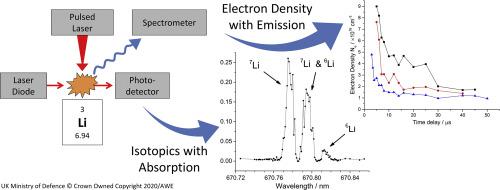当前位置:
X-MOL 学术
›
Spectrochim. Acta B. At. Spectrosc.
›
论文详情
Our official English website, www.x-mol.net, welcomes your feedback! (Note: you will need to create a separate account there.)
Isotopic analysis and plasma diagnostics for lithium detection using combined laser ablation–tuneable diode laser absorption spectroscopy and laser-induced breakdown spectroscopy
Spectrochimica Acta Part B: Atomic Spectroscopy ( IF 3.3 ) Pub Date : 2021-03-01 , DOI: 10.1016/j.sab.2020.106051 Gregory Hull , Edward D. McNaghten , Paul Coffey , Philip Martin
Spectrochimica Acta Part B: Atomic Spectroscopy ( IF 3.3 ) Pub Date : 2021-03-01 , DOI: 10.1016/j.sab.2020.106051 Gregory Hull , Edward D. McNaghten , Paul Coffey , Philip Martin

|
Abstract Laser-Induced Breakdown Spectroscopy (LIBS) enables rapid stand-off measurements of potentially hazardous material which is particularly favourable for applications in the nuclear industry. Isotopic characterisation with LIBS remains challenging because of the narrow separation of isotopic emission lines, which demands large, high resolution spectrometers. To address this, laser ablation (LA)-Tuneable Diode Laser Absorption Spectroscopy (TDLAS) has been combined with LIBS to analyse laser-produced plasma of lithium. Isotope ratio calculations were performed by fitting multiple peaks to the Li absorption spectra, achieving a relative error of 13% at later delay times after line broadening had reduced. Double-pulsed laser ablation resulted in narrower absorption peaks but more noise in the absorption spectra. LIBS and LA-TDLAS spectra were used simultaneously to calculate plasma temperature and electron density for both single- and double-pulsed laser ablation. The Doppler broadening of absorption peaks from LA-TDLAS was used to calculate the plasma temperature after long time delays of 200 μs and the temperature followed an exponential decay which was extrapolated back to early delay times in order to predict the temperature throughout the plasma lifecycle. The electron density was calculated using the Stark broadening of emission peaks from the LIBS spectra, which were temperature-corrected by accounting for the Doppler broadening. Both single- and double-pulsed-laser ablation plasmas exhibited maximum electron densities of around 1016 to 1017 cm−3, although the decay rate was reduced by around a factor of 2 using DP-laser ablation. We have shown that the combination of emission and absorption spectroscopy with LIBS and LA-TDLAS is useful for isotopic analysis and calculating laser ablation plasma properties. We have demonstrated that double pulsed laser ablation has the potential to enable more isotopic pairs to be analysed due to the narrower absorption linewidth.
中文翻译:

使用组合激光烧蚀-可调二极管激光吸收光谱和激光诱导击穿光谱进行锂检测的同位素分析和等离子体诊断
摘要 激光诱导击穿光谱 (LIBS) 能够对潜在危险材料进行快速隔离测量,这特别有利于核工业中的应用。使用 LIBS 进行同位素表征仍然具有挑战性,因为同位素发射线的间隔很窄,这需要大型、高分辨率的光谱仪。为了解决这个问题,激光烧蚀 (LA)-可调二极管激光吸收光谱 (TDLAS) 已与 LIBS 相结合,以分析激光产生的锂等离子体。同位素比计算是通过将多个峰拟合到锂吸收光谱来进行的,在谱线展宽减少后的延迟时间实现了 13% 的相对误差。双脉冲激光烧蚀导致吸收峰更窄,但吸收光谱中的噪声更大。LIBS 和 LA-TDLAS 光谱同时用于计算单脉冲和双脉冲激光烧蚀的等离子体温度和电子密度。来自 LA-TDLAS 的吸收峰的多普勒展宽用于计算 200 μs 长时间延迟后的等离子体温度,并且温度遵循指数衰减,该衰减被外推回早期延迟时间,以预测整个等离子体生命周期的温度。使用来自 LIBS 光谱的发射峰的斯塔克展宽计算电子密度,通过考虑多普勒展宽对其进行温度校正。单脉冲和双脉冲激光烧蚀等离子体均表现出约 1016 至 1017 cm-3 的最大电子密度,尽管使用 DP 激光烧蚀使衰减率降低了约 2 倍。我们已经表明,发射和吸收光谱与 LIBS 和 LA-TDLAS 的组合对于同位素分析和计算激光烧蚀等离子体特性非常有用。我们已经证明,由于吸收线宽更窄,双脉冲激光烧蚀有可能分析更多同位素对。
更新日期:2021-03-01
中文翻译:

使用组合激光烧蚀-可调二极管激光吸收光谱和激光诱导击穿光谱进行锂检测的同位素分析和等离子体诊断
摘要 激光诱导击穿光谱 (LIBS) 能够对潜在危险材料进行快速隔离测量,这特别有利于核工业中的应用。使用 LIBS 进行同位素表征仍然具有挑战性,因为同位素发射线的间隔很窄,这需要大型、高分辨率的光谱仪。为了解决这个问题,激光烧蚀 (LA)-可调二极管激光吸收光谱 (TDLAS) 已与 LIBS 相结合,以分析激光产生的锂等离子体。同位素比计算是通过将多个峰拟合到锂吸收光谱来进行的,在谱线展宽减少后的延迟时间实现了 13% 的相对误差。双脉冲激光烧蚀导致吸收峰更窄,但吸收光谱中的噪声更大。LIBS 和 LA-TDLAS 光谱同时用于计算单脉冲和双脉冲激光烧蚀的等离子体温度和电子密度。来自 LA-TDLAS 的吸收峰的多普勒展宽用于计算 200 μs 长时间延迟后的等离子体温度,并且温度遵循指数衰减,该衰减被外推回早期延迟时间,以预测整个等离子体生命周期的温度。使用来自 LIBS 光谱的发射峰的斯塔克展宽计算电子密度,通过考虑多普勒展宽对其进行温度校正。单脉冲和双脉冲激光烧蚀等离子体均表现出约 1016 至 1017 cm-3 的最大电子密度,尽管使用 DP 激光烧蚀使衰减率降低了约 2 倍。我们已经表明,发射和吸收光谱与 LIBS 和 LA-TDLAS 的组合对于同位素分析和计算激光烧蚀等离子体特性非常有用。我们已经证明,由于吸收线宽更窄,双脉冲激光烧蚀有可能分析更多同位素对。



























 京公网安备 11010802027423号
京公网安备 11010802027423号